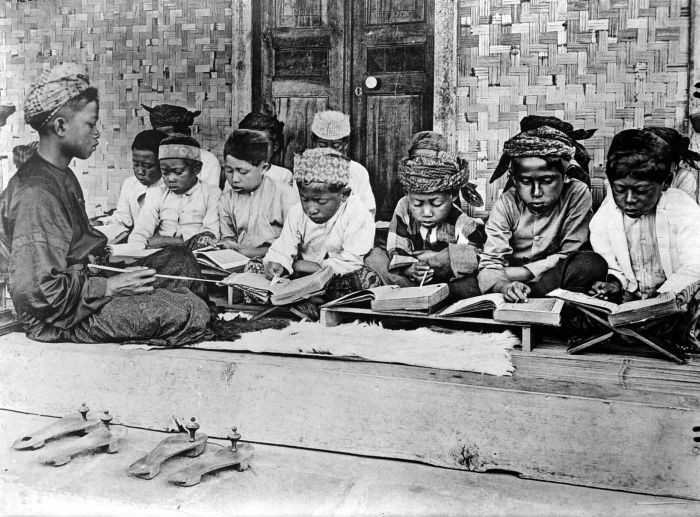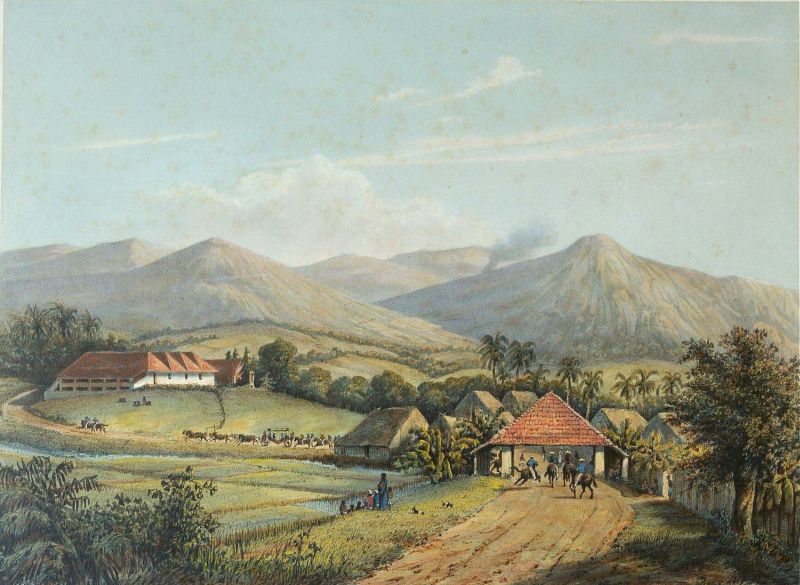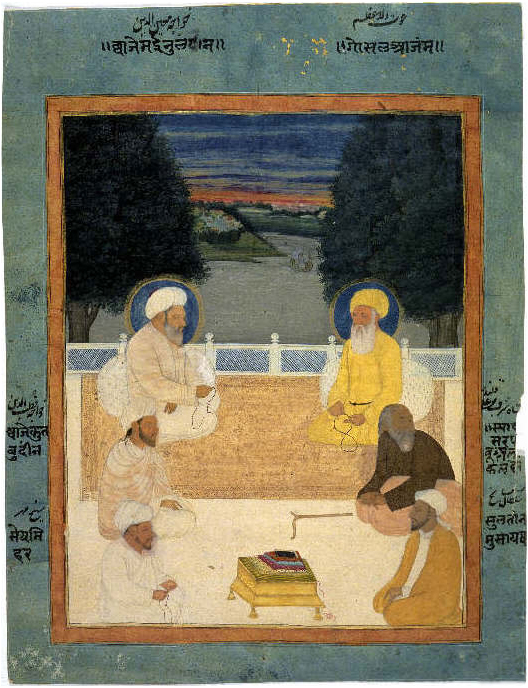|
Surau
A surau is an Islamic assembly building in some regions of Sumatra and the Malay Peninsula, used for worship and religious instruction. Generally smaller physical structures, their ritual functions are similar to those of a mosque, they admit men and women, and they are used more for religious instruction and festive prayers. Surau mostly depend on grassroots support and funding and can be compared to the Arab zawiya. In the Minangkabau society of West Sumatra, Indonesia, they are built on high posts and maintain pre-Islamic traditions of a men's house. In contemporary usage, "surau" is often used to refer to either a small mosque or a designated room in a public building (such as a shopping mall, a university, or a rest stop along a highway) for men or women to perform salah. Indonesia Surau among the Minangkabau of West Sumatra date to pre-Islamic times, as men's communal accommodation. The first such surau is believed to have been built in the late 17th century, in ... [...More Info...] [...Related Items...] OR: [Wikipedia] [Google] [Baidu] [Amazon] |
Burhanuddin Ulakan
Burhanuddin Ulakan Pariaman (1646–1704), also known as Sheikh Burhanuddin Ulakan, was an Islamic cleric (ulama) from the Minangkabau Highlands, Minangkabau region. He is regarded as the pioneer of Islamic propagators in West Sumatra. pp.286-289.Burhanuddin Ulakan, Kematian 1704 . ''Relasi Data''. Retrieved 29 April 2014. He is also known as a commanding figure of the Islamic movements against the Dutch East Indies, Dutch colonization. Regarding his Islamic belief, he was a Sufi ''murshid'' (scholar of spirituality) belonging to the Shattari tariqa based in Minangkabau region. pp.304-307. Biography Early life and education Burhanuddin was born under the name Pono.[...More Info...] [...Related Items...] OR: [Wikipedia] [Google] [Baidu] [Amazon] |
Pesantren
''Pesantren'' is a traditional Islamic boarding school in Indonesia. It is taught either in private houses, a ''wiktionary:pondok, pondok'' or a mosque, the teaching includes classical Islamic texts and ''santri'' thought, taught by Kyai, ''kyais''. According to one popular tradition, the ''pesantren'' education system originated from traditional Javanese ''pondokan'', dormitories, ashram, ashrams for Hindu, Hindus or viharas for Buddhists to learn religious philosophies, martial arts, and meditation. Institutions much like them are found across the Islamic world and are called ''pondok'' in Malaysia, Southern Thailand and ''madrasa, madrasas'' in India and Pakistan and much of the Arabic-speaking world. The ''pesantren'' aims to deepen knowledge of the Quran, particularly through the study of Arabic, traditions of exegesis, the Hadith, Sayings of the Prophet, law and logic. The term ''pesantren'' derives from the root word ''santri'' or student -- ''pe-santri-an'' or the place o ... [...More Info...] [...Related Items...] OR: [Wikipedia] [Google] [Baidu] [Amazon] |
Architecture Of Indonesia
The architecture of Indonesia reflects the diversity of Culture of Indonesia, cultural, History of Indonesia, historical, and Geography of Indonesia, geographic influences that have shaped Indonesia as a whole. Invaders, colonizers, missionaries, merchants, and traders brought cultural changes that had a profound effect on building styles and techniques. Numbers of Indonesian Rumah adat, vernacular houses have been developed throughout the archipelago. The traditional houses and settlements of the several hundred ethnic groups of Indonesia are extremely varied and all have their specific history. The houses hold social significance in society and demonstrate local ingenuity in their relations to the environment and spatial organisation. Traditionally, the most significant foreign influence has been India. However, Chinese, Arab, and European influences have also played significant roles in shaping Indonesian architecture. Religious architecture varies from indigenous forms to m ... [...More Info...] [...Related Items...] OR: [Wikipedia] [Google] [Baidu] [Amazon] |
Rest Stop
A rest area is a public facility located next to a large thoroughfare such as a motorway, Limited-access road, expressway, or highway, at which drivers and passengers can rest, eat, or refuel without exiting onto secondary roads. Other names include motorway service area (UK), services (UK), travel plaza, rest stop, oasis (US), service area, rest and service area (RSA), resto, service plaza, lay-by, service centre, and onroute (Ontario, Canada). Facilities may include park-like areas, filling station, fuel stations, public toilets, water fountains, restaurants, and Holding tank dump station, dump and fill stations for Caravan (towed trailer), caravans and motorhomes. A rest area with limited to no public facilities is a lay-by, parking area, scenic area, or scenic overlook. Along some highways and roads are services known as wayside parks, roadside parks, or picnic areas. Overview The availability, standards and upkeep of facilities at a stop vary by jurisdiction. Servi ... [...More Info...] [...Related Items...] OR: [Wikipedia] [Google] [Baidu] [Amazon] |
Zawiya (institution)
A ''zawiya'' or ''zaouia'' (; ; also spelled ''zawiyah'' or ''zawiyya'') is a building and institution associated with Sufism, Sufis in the Islamic world. It can serve a variety of functions such a place of worship, school, monastery and/or mausoleum. In some regions the term is interchangeable with the term ''khanqah'', which serves a similar purpose. In the Maghreb, the term is often used for a place where the founder of a Sufi order or a local saint or holy man (e.g. a ''wali'') lived and was buried. In the Maghreb the word can also be used to refer to the wider ''tariqa'' (Sufi order or brotherhood) and its membership. Etymology The Arabic term () translates literally as "corner" or "nook". The term was first applied to the cells of Christian monks, before the meaning was applied to a small mosque or prayer room. In the later medieval period, it came to denote a structure housing a Sufi brotherhood, especially in North Africa. In modern times, the word has still retained t ... [...More Info...] [...Related Items...] OR: [Wikipedia] [Google] [Baidu] [Amazon] |
Padang Panjang
Padang Panjang (sometimes written as Padangpanjang, and spelt as Padang Pandjang in the Dutch East Indies era, , Jawi: ), is a city located at in the highlands of West Sumatra, around 80 Km inland from the provincial capital Padang. It sits on a plateau beneath the volcanoes Mount Marapi and Mount Singgalang, thus creating cooler temperatures. It was a popular tourist destination during Dutch rule in Indonesia, and it later became one of the centres of Islamic education in Sumatra. Home to a famous performing arts conservatorium, Institut Seni Indonesia Padang Panjang' (Indonesian Art Institute Padang Panjang). The town stretches up the hill from the marketplace and central mosque to the soccer field and bus terminal up to ISI. The main road through Padang Panjang links coastal Padang and the highland capital, Bukittinggi. The city is also home to the Minangkabau Cultural Documentation and Information Center ( Indonesian: ''Pusat Dokumentasi dan Informasi Kebudayaan Minangka ... [...More Info...] [...Related Items...] OR: [Wikipedia] [Google] [Baidu] [Amazon] |
Java
Java is one of the Greater Sunda Islands in Indonesia. It is bordered by the Indian Ocean to the south and the Java Sea (a part of Pacific Ocean) to the north. With a population of 156.9 million people (including Madura) in mid 2024, projected to rise to 158 million at mid 2025, Java is the world's List of islands by population, most populous island, home to approximately 55.7% of the Demographics of Indonesia, Indonesian population (only approximately 44.3% of Indonesian population live outside Java). Indonesia's capital city, Jakarta, is on Java's northwestern coast. Many of the best known events in Indonesian history took place on Java. It was the centre of powerful Hindu-Buddhist empires, the Islamic sultanates, and the core of the colonial Dutch East Indies. Java was also the center of the History of Indonesia, Indonesian struggle for independence during the 1930s and 1940s. Java dominates Indonesia politically, economically and culturally. Four of Indonesia's eig ... [...More Info...] [...Related Items...] OR: [Wikipedia] [Google] [Baidu] [Amazon] |
Sufism
Sufism ( or ) is a mysticism, mystic body of religious practice found within Islam which is characterized by a focus on Islamic Tazkiyah, purification, spirituality, ritualism, and Asceticism#Islam, asceticism. Practitioners of Sufism are referred to as "Sufis" (from , ), and historically typically belonged to "orders" known as (pl. ) — congregations formed around a grand (saint) who would be the last in a Silsilah, chain of successive teachers linking back to Muhammad, with the goal of undergoing (self purification) and the hope of reaching the Maqam (Sufism), spiritual station of . The ultimate aim of Sufis is to seek the pleasure of God by endeavoring to return to their original state of purity and natural disposition, known as . Sufism emerged early on in Islamic history, partly as a reaction against the expansion of the early Umayyad Caliphate (661–750) and mainly under the tutelage of Hasan al-Basri. Although Sufis were opposed to dry legalism, they strictly obs ... [...More Info...] [...Related Items...] OR: [Wikipedia] [Google] [Baidu] [Amazon] |
Shattariyya
The Shattari or Shattariyya are members of a Sufi order that originated in Safavid Iran in the fifteenth century and developed, completed, and codified in India. Later, secondary branches were taken to the Hejaz and to Indonesia. The word Shattar, which means "lightning-quick," "speed," "rapidity," See Appendix II: The Rapidness. First published in 1964. or "fast-goer" Eight-volume set. shows a system of spiritual practices that lead to a state of "completion," but the name derives from its founder, Abdullah Shattar (d. 1406). Unlike other Sufis, the Shattariyya do not subscribe to the concept of fana (annihilation of the ego). "With the sect of Shattaris, the ''Salik'' (seeker, aspirant) descends, of himself, in his knowledge - there is no annihilation of self with them." Quoting Khaja Khan's book on Tasawwuf.In that book, however, Khan is not recommending this course of action, seeing it as a "thorny path" (p15) and commenting that "Imagination and judgment are upset, and ... [...More Info...] [...Related Items...] OR: [Wikipedia] [Google] [Baidu] [Amazon] |
Abd Al-Rauf Al-Fansuri
Amin al-Din Abd al-Rauf ibn Ali al-Jawi al-Fansuri al-Sinkili ( Jawoë: أمين الدين عبد الرؤوف بن علي الجاوي الفنسوري السنكيلي) known as Syiah Kuala (spelling variation ''Abdurrauf Singkil'', 1615–1693 CE) was a renowned Islamic scholar, spiritual leader of the Shattariyya tariqa and mufti of the Aceh Sultanate. He was a confidant of Sultana Safiat al-Din and first to spread the Shattari Sufi order in Indonesia and Southeast Asia. Many of his students became disseminators of Islam. He is commonly known as Sheikh Abd al-Rauf al-Sinkili and posthumously as Teungku Syiah Kuala ( Acehnese: "Sheikh in the Estuary"). Al-Sinkili was believed to be a native of Singkil, a town on the western coast of Aceh. Beside being called Al-Sinkili, his other attribution (Arabic: '' nisba'') was Al-Fansuri, relating him to the town of Barus. He could be related to another prominent Sufi poet and writer from that town, Hamzah Fansuri. Early life Hi ... [...More Info...] [...Related Items...] OR: [Wikipedia] [Google] [Baidu] [Amazon] |
Quran
The Quran, also Romanization, romanized Qur'an or Koran, is the central religious text of Islam, believed by Muslims to be a Waḥy, revelation directly from God in Islam, God (''Allah, Allāh''). It is organized in 114 chapters (, ) which consist of individual verses ('). Besides its religious significance, it is widely regarded as the finest work in Arabic literature, and has significantly influenced the Arabic, Arabic language. It is the object of a modern field of academic research known as Quranic studies. Muslims believe the Quran was orally revealed by God to the final Islamic Prophets and messengers in Islam, prophet Muhammad in Islam, Muhammad through the Angel#Islam, angel Gabriel#Islam, Gabriel incrementally over a period of some 23 years, beginning on the Night of Power, Laylat al-Qadr, when Muhammad was 40, and concluding in 632, the year of his death. Muslims regard the Quran as Muhammad's most important Islamic view of miracles, miracle, a proof of his prophet ... [...More Info...] [...Related Items...] OR: [Wikipedia] [Google] [Baidu] [Amazon] |
Naqshbandi
Naqshbandi (Persian: نقشبندیه) is a major Sufi order within Sunni Islam, named after its 14th-century founder, Baha' al-Din Naqshband. Practitioners, known as Naqshbandis, trace their spiritual lineage (silsila) directly to the Prophet Muhammad through the first caliph, Abu Bakr, via Ja'far al-Sadiq. This order is distinct for its strict adherence to Sharia and silent dhikr practices adopted from earlier Central Asian masters. History The order is also known as the "convergence of the two oceans" due to the presence of Abu Bakr and Jafar al-Sadiq in the silsilah, ''silsila'' and the "Sufi Order of Jafar al-Sadiq". The Naqshbandi order owes many insights to Yusuf Hamadani and Abdul Khaliq Ghijduwani in the 12th century, the latter of whom is regarded as the organizer of the practices and is responsible for placing stress upon the purely silent dhikr, remembrance of Allah. It was later associated with Baha-ud-Din Naqshband Bukhari, Baha al-Din Shah Naqshband in the ... [...More Info...] [...Related Items...] OR: [Wikipedia] [Google] [Baidu] [Amazon] |






